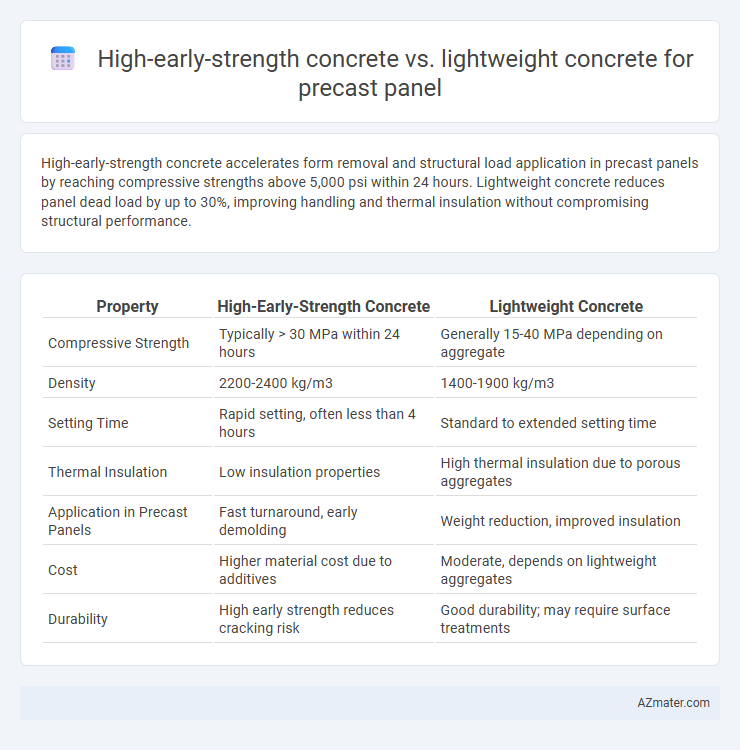High-early-strength concrete accelerates form removal and structural load application in precast panels by reaching compressive strengths above 5,000 psi within 24 hours. Lightweight concrete reduces panel dead load by up to 30%, improving handling and thermal insulation without compromising structural performance.
Table of Comparison
| Property | High-Early-Strength Concrete | Lightweight Concrete |
|---|---|---|
| Compressive Strength | Typically > 30 MPa within 24 hours | Generally 15-40 MPa depending on aggregate |
| Density | 2200-2400 kg/m3 | 1400-1900 kg/m3 |
| Setting Time | Rapid setting, often less than 4 hours | Standard to extended setting time |
| Thermal Insulation | Low insulation properties | High thermal insulation due to porous aggregates |
| Application in Precast Panels | Fast turnaround, early demolding | Weight reduction, improved insulation |
| Cost | Higher material cost due to additives | Moderate, depends on lightweight aggregates |
| Durability | High early strength reduces cracking risk | Good durability; may require surface treatments |
Introduction to Precast Panels: Material Choices
High-early-strength concrete accelerates the curing process, enabling rapid demolding and faster production cycles for precast panels, making it ideal for projects with tight schedules. Lightweight concrete reduces the panel's overall weight, enhancing ease of handling and transportation while improving thermal insulation properties. Selecting between these materials depends on project priorities such as structural load, thermal performance, and construction timeline demands.
Overview of High-Early-Strength Concrete
High-early-strength concrete achieves compressive strength typically above 20 MPa within 24 hours, allowing for faster formwork removal and accelerated construction schedules in precast panel production. This concrete type utilizes specialized cement blends, such as Type III Portland cement or supplementary cementitious materials, to enhance early hydration rates and strength gain. Its accelerated curing properties make it ideal for precast applications requiring rapid turnaround, though it may exhibit higher heat generation and cost compared to conventional or lightweight concrete.
Defining Lightweight Concrete for Precast Applications
Lightweight concrete for precast panels is defined by its reduced density, typically ranging from 90 to 115 pounds per cubic foot, achieved by incorporating lightweight aggregates like expanded clay or shale. This lower density enhances structural efficiency by reducing dead loads while maintaining adequate compressive strength, often between 3000 and 6000 psi, suitable for building envelope and interior wall systems. In contrast to high-early-strength concrete, lightweight concrete balances strength and thermal insulation properties, making it ideal for energy-efficient and lightweight precast construction.
Strength and Performance Comparison
High-early-strength concrete achieves compressive strengths above 20 MPa within 24 hours, enabling faster formwork removal and reduced construction time for precast panels. Lightweight concrete typically has lower compressive strength, ranging between 10 to 30 MPa, but offers superior thermal insulation and reduced dead load, benefiting overall structural performance. In terms of durability and load-bearing capacity, high-early-strength concrete provides superior mechanical performance, while lightweight concrete enhances energy efficiency and ease of handling during panel manufacturing.
Weight and Handling: Logistics Implications
High-early-strength concrete offers superior load-bearing capacity but typically has a higher density, increasing the weight of precast panels and complicating transportation and on-site handling. Lightweight concrete reduces panel weight by up to 30-40%, streamlining logistics through easier lifting, faster installation, and lower transportation costs without compromising structural integrity. Selecting lightweight concrete for precast panels optimizes project efficiency by minimizing handling challenges and improving overall supply chain management.
Speed of Construction with Each Concrete Type
High-early-strength concrete accelerates the curing process, enabling precast panels to reach sufficient strength within 24 hours, which significantly reduces formwork removal time and speeds up construction schedules. Lightweight concrete, while beneficial for reducing dead load and improving thermal insulation, generally requires longer curing periods, potentially slowing down the production and installation of precast panels. Choosing high-early-strength concrete optimizes rapid project turnaround, whereas lightweight concrete prioritizes structural efficiency over speed.
Durability and Longevity Considerations
High-early-strength concrete offers superior early load-bearing capacity and rapid strength gain essential for quick turnover in precast panel production, but its denser matrix may be more susceptible to shrinkage cracks affecting long-term durability. Lightweight concrete provides enhanced durability through lower thermal conductivity and improved freeze-thaw resistance, reducing the risk of structural degradation in harsh environments. For longevity considerations, lightweight concrete's reduced density also lowers self-weight, mitigating stress on structural supports and extending the lifespan of precast panels in seismic or dynamic load conditions.
Cost Analysis: Material and Lifecycle Expenses
High-early-strength concrete offers faster curing times, reducing production cycle durations and labor costs in precast panel manufacturing, but its higher cement content elevates initial material expenses. Lightweight concrete panels, while generally more expensive in raw materials due to additives like expanded clay or shale, provide significant savings in transportation and installation costs because of reduced weight. Lifecycle expenses favor lightweight panels by improving thermal insulation, thus lowering energy costs during building operation, whereas high-early-strength concrete panels contribute to quicker project turnover and earlier revenue realization.
Sustainability and Environmental Impact
High-early-strength concrete accelerates construction timelines, reducing energy consumption and associated carbon emissions during formwork and curing phases, yet involves higher cement content contributing to increased embodied CO2. Lightweight concrete, by incorporating recycled aggregates or industrial by-products, lowers the structural load and enhances thermal insulation, which reduces operational energy demands and supports sustainable building practices. Balancing these materials in precast panels optimizes environmental benefits through both reduced carbon footprint and improved energy efficiency across the building lifecycle.
Choosing the Right Concrete for Your Precast Project
High-early-strength concrete accelerates form removal and reduces construction time, making it ideal for projects with tight schedules, while lightweight concrete offers enhanced thermal insulation and reduced panel weight, improving handling and structural load efficiency. Selecting the appropriate concrete depends on project requirements such as load capacity, thermal performance, and production speed. Evaluating the balance between strength gain rate and weight can optimize precast panel durability, safety, and overall project cost-efficiency.

Infographic: High-early-strength concrete vs Lightweight concrete for Precast panel
 azmater.com
azmater.com